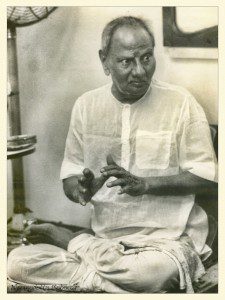Okay, I can’t really support the assertion that Sri Nisargadatta is in fact the Buddhists’ favorite Hindu. Maybe its Mahatma Gandhi. Or? Don’t really know. But, I do know we like to quote Nisargadatta.
I was just reading a book on the practice of Jhanas, pretty inside Buddhist baseball. And there it was:
Reality is not the result of a process; it is an explosion. It is definitely beyond the mind, but all you can do is to know your mind well. Not that the mind will help you, but by knowing your mind you may avoid your mind disabling you. You have to be very alert, or else your mind will play false with you. It is like watching a thief – not that you expect anything from a thief, but you do not want to be robbed. In the same way you give a lot of attention to the mind without expecting anything from it.
Me, I’ve made hay on a couple of occasions with something else he wrote:
Wisdom is knowing I am nothing, love is knowing I am everything, and between the two my life moves.
So who is this guy?
He was born Maruti Shivrampant Kambil in Bombay, India in 1897. His family was poor, although not as poor as one can be in India. His father worked as a servant and then had a small farm. As a young adult he worked briefly in an office, but soon opened a tiny store specializing in selling beedis, a form of cheap cigarette, and eventually expanded to have more than a half dozen stores. He married in 1924, he and his wife Sumatibai had four children.
He began studying with Siddharameshwar Maharaj, a guru in the Shiva Advaita tradition, who startled him with the assertion “you are not what you take yourself to be,” and who then gave him the practice of attending to the sense of “I am” as a mantra. He did. He reports of that time “I simply followed his instruction, which was to focus the mind on pure being, ‘I am,’ and stay in it. I used to sit for hours together, with nothing but the “I am” in my mind and soon the peace and joy and deep all-embracing love became my normal state. In it all disappeared—myself, my guru, the life I lived, the world around me. Only peace remained, and unfathomable silence.”
In my tradition, and I believe his this would be called samadhi, a state of one pointed absorption.
His guru died soon after, they had been together for only two and a half years. He briefly left his family on a spiritual quest, but decided abandoning his family wasn’t right, and decided to return home. It was on that way home that he had his awakening. My brief research didn’t show the circumstances beyond that decision to return home. Still, I find that decision and its proximity to his deepest insights compelling, particularly in the light of the Buddhist founding story.
He didn’t begin actively teaching until after his wife died and his children (one of them had died, as well) grew up. His life as a teacher invites comparisons with classic Zen teachers, with a passionate, sometimes called ruthless approach to teaching, and emphasizing an experience of “sudden awakening.” He had little truck with spiritual tourists.
He died in 1981.
He is best known in the West through a single book, I Am That.
Many, but not all of the quotes that many Buddhists find compelling come from that book.
Here are a few of those quotes.
We are the creators and creatures of each other, causing and bearing each other’s burden.
Another:
A quiet mind is all you need. All else will happen rightly, once your mind is quiet. As the sun on rising makes the world active, so does self-awareness affect changes in the mind. In the light of calm and steady self-awareness, inner energies wake up and work miracles
without any effort on your part.
And one more:
Love is not selective, desire is selective. In love there are no strangers. When the centre of selfishness is no longer, all desires for pleasure and fear of pain cease; one is no longer interested in being happy; beyond happiness there is pure intensity, inexhaustible energy, the ecstasy of giving from a perennial source.
Among the things I like about him, is that his teachings are similar, sometimes shockingly similar to those of my tradition, but at other times not, on occasion even at odds. I’m particularly fascinated by his guru devotion, something I consider dangerous at best, and the stream of bhakti that runs a deep current through his teachings.
Keeps me on my toes, or, even inspires me to kneel before the great mystery, seen as a dancing god.
There are many ways to open the heart mind.
No doubt…
There’s a ton more about him on the web, and on Youtube. Check him out.













